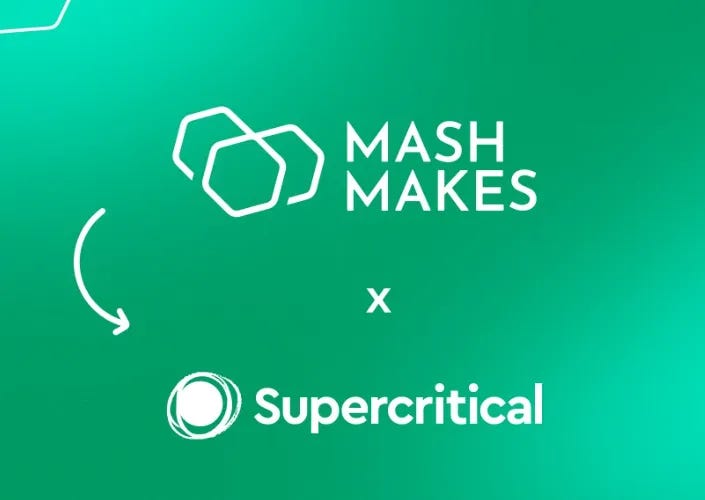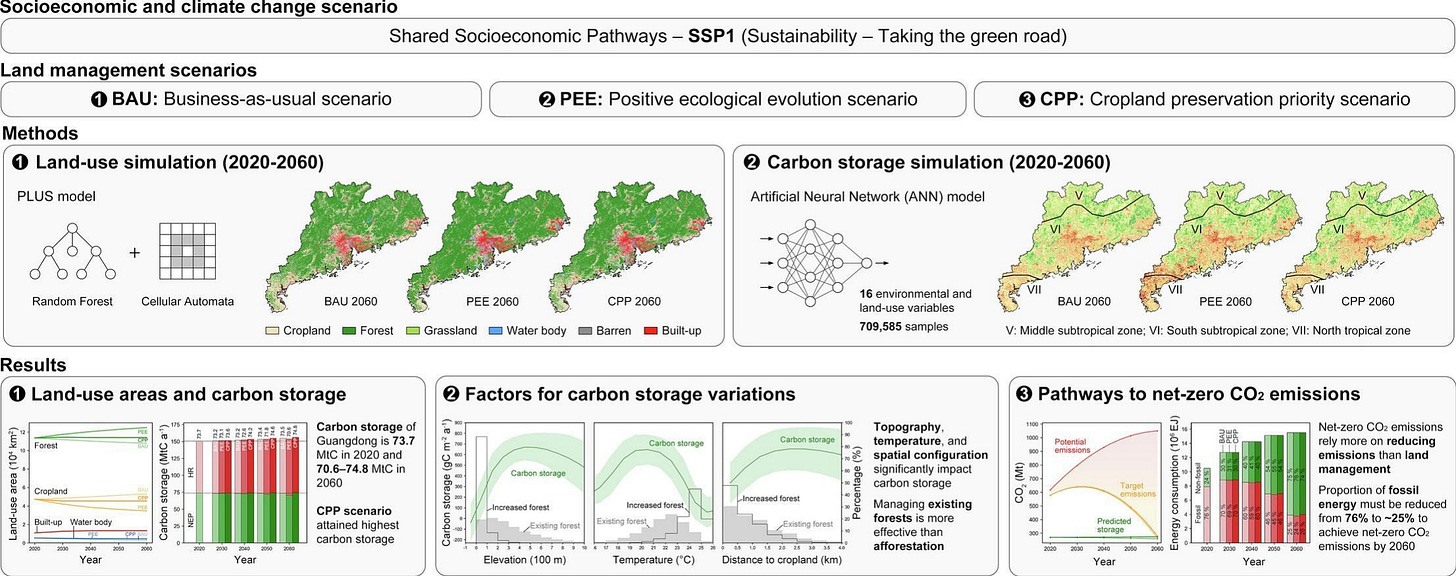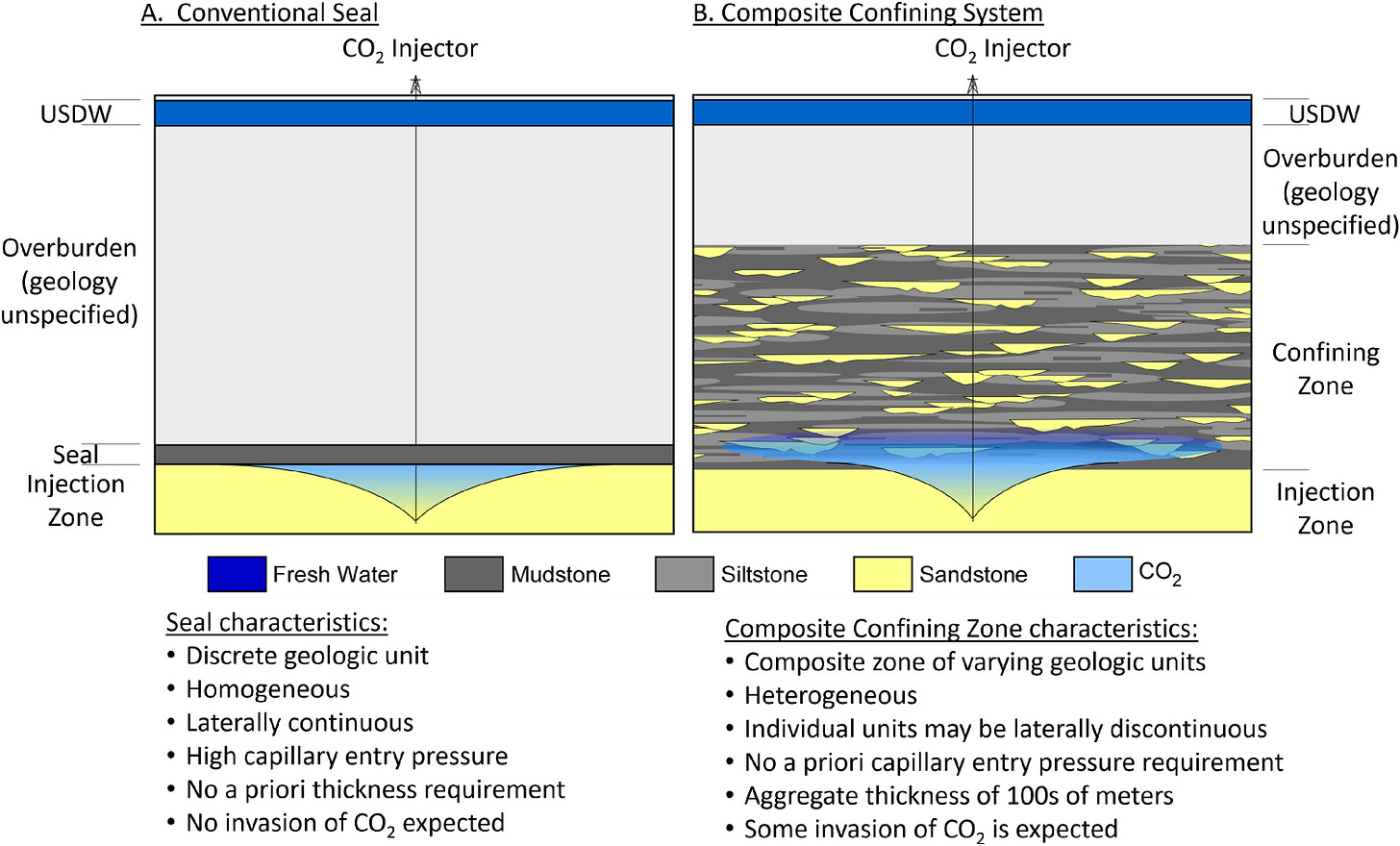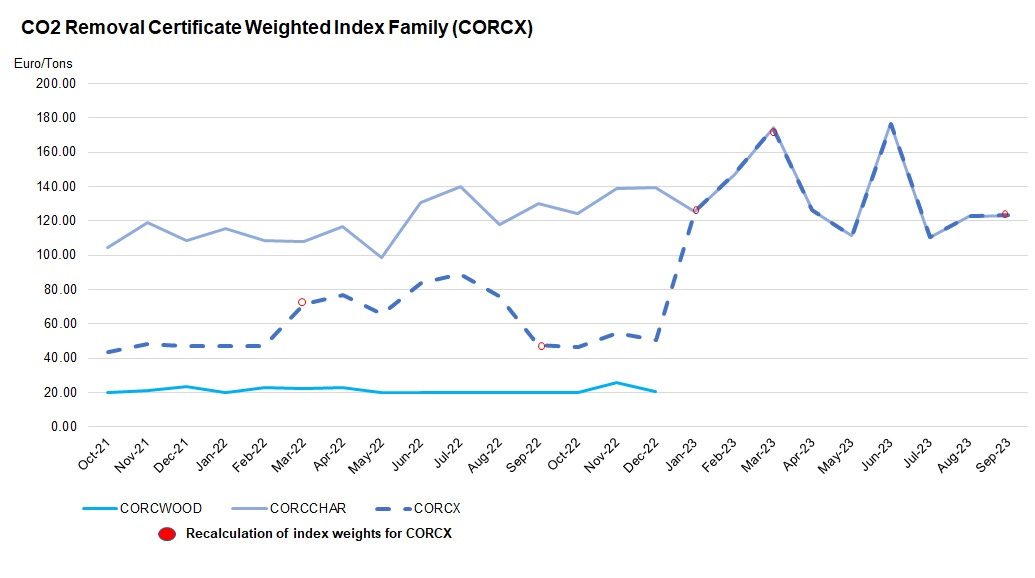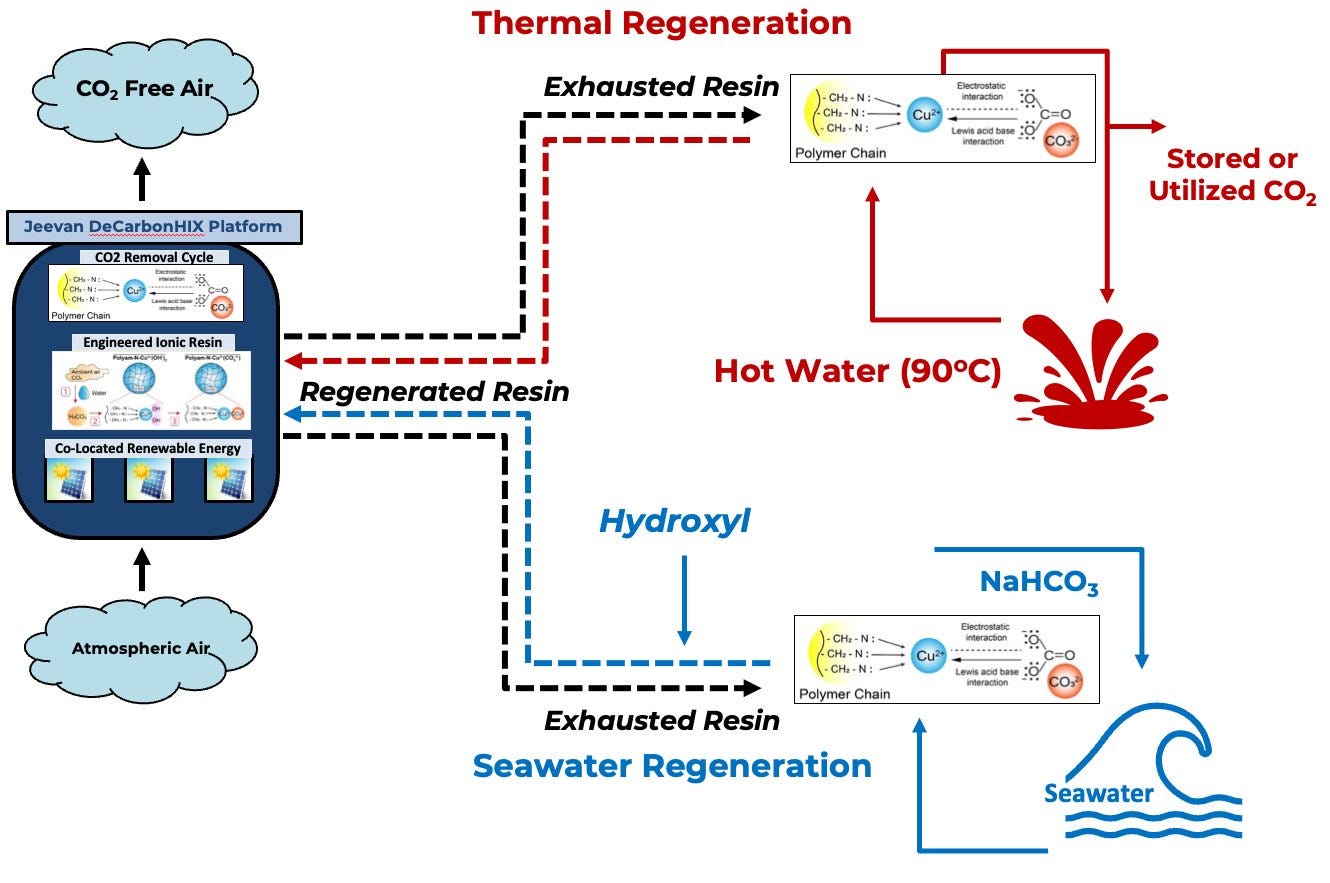CARBON REMOVAL WEEKLY SUMMARY (09 OCTOBER - 15 OCTOBER 2023)-WEEK#34
Links to recent scientific papers, web posts, upcoming events, job opportunities, podcasts, and event recordings, etc. on Carbon Dioxide Removal Technology.
💸COMMERCIAL NEWS
MASH Makes And Supercritical Partner On 10,000 Tons Of Carbon Removal (Carbon Herald)
easyJet signs up to Airbus’ pioneering carbon removal solution (AIRBUS)
Aramco, Siemens Energy to Sign Direct Air-Capture Deal (Bloomberg)
Cellular Goods joins kelp farming and carbon removal joint venture (Proactive Innovators)
📝RESEARCH PAPERS
Potential for biochar carbon sequestration from crop residues: A global spatially explicit assessment
Karan, S. K., Woolf, D., Azzi, E. S., Sundberg, C., Wood, S. A. (2023). Potential for biochar carbon sequestration from crop residues: A global spatially explicit assessment. Bioproducts for Sustainable Bioeconomy.
Process-Performance of Solid Sorbents For Direct Air Capture (Dac) of Co2 In Optimized Temperature-Vacuum Swing Adsorption (Tvsa) Cycles
Balasubramaniam, B. M., Thierry, P. T., Lethier, S., Pugnet, V., Rajendran, A., & LLEWELLYN, P. (2023). Process-Performance of Solid Sorbents For Direct Air Capture (Dac) of Co2 In Optimized Temperature-Vacuum Swing Adsorption (Tvsa) Cycles. Available at SSRN 4580659.
The role of BECCS technology in achieving carbon neutrality: evidences from China’ coal power sector
Zhang, Y. L., Kang, J. N., Dai, M., Hou, J. J., Liu, L. C., Wei, Y. M., & Liao, H. (2023). The role of BECCS technology in achieving carbon neutrality: evidences from China’s coal power sector. Environment, Development and Sustainability, 1-25.
Data-Driven Analysis of Amine-Based Sorbents for CO2 Removal from the Atmosphere
Bahmanpour, A. M., Tegeler, E. B., Colbert, T., & Masoudi, M. (2023). Data‐Driven Analysis of Amine‐Based Sorbents for CO2 Removal from the Atmosphere. Chemical Engineering & Technology.
Valuing the ocean carbon sink at the country level
Rickels, W., Karstensen, J., Meier, F., Peterson, S., Ruehland, S., Thube, S., ... & Wolff, C. (2023). Valuing the ocean carbon sink at the country level.
Developing integrated direct air capture and bioenergy with carbon capture and storage systems: progress towards 2 °C and 1.5 °C climate goals
Okonkwo, E. C., AlNouss, A., Shahbaz, M., & Al-Ansari, T. (2023). Developing integrated direct air capture and bioenergy with carbon capture and storage systems: progress towards 2° C and 1.5° C climate goals. Energy Conversion and Management, 296, 117687.
Ecosystem carbon storage considering combined environmental and land-use changes in the future and pathways to carbon neutrality in developed regions
Liu, J., Yan, Q., & Zhang, M. (2023). Ecosystem carbon storage considering combined environmental and land-use changes in the future and pathways to carbon neutrality in developed regions. Science of The Total Environment, 903, 166204.
Soil carbon sequestration potential bounded by population growth, land availability, food production, and climate change
Keel, S. G., Bretscher, D., Leifeld, J., von Ow, A., & Wüst-Galley, C. (2023). Soil carbon sequestration potential bounded by population growth, land availability, food production, and climate change. Carbon Management, 14(1), 2244456.
Carbon stock in biomass pool of fragmented mangrove habitats of Kochi, Southern India
Rani, V., Nandan, S. B., Jayachandran, P. R., Preethy, C. M., Sreelekshmi, S., Joseph, P., & Asha, C. V. (2023). Carbon stock in biomass pool of fragmented mangrove habitats of Kochi, Southern India. Environmental Science and Pollution Research, 30(43), 96746-96762.
Assessment of the Retrofit Potential of Existing Wellbores for Geologic CO2 Sequestration Applications
Heimerl, J., Ma, Z., Chen, B., Mehana, M., & Van Wijk, J. (2023, May). Assessment of the Retrofit Potential of Existing Wellbores for Geologic CO2 Sequestration Applications. In SPE Western Regional Meeting (p. D021S005R004). SPE.
Microwave energy radiated biochar bonded-cement-clay bricks
Akinyemi, B. A., Hagare, D., & Oluwadamilare, A. (2023). Microwave energy radiated biochar bonded-cement-clay bricks. Journal of Building Pathology and Rehabilitation, 8(2), 94.
Reconstructing the ocean's mesopelagic zone carbon budget: sensitivity and estimation of parameters associated with prokaryotic remineralization
Baumas, C., Fuchs, R., Garel, M., Poggiale, J. C., Memery, L., Le Moigne, F. A., & Tamburini, C. (2023). Reconstructing the ocean’s mesopelagic zone carbon budget: sensitivity and estimation of parameters associated with prokaryotic remineralization. Biogeosciences Discussions, 1-39.
Biomass residue to carbon dioxide removal: quantifying the global impact of biochar
Lefebvre, D., Fawzy, S., Aquije, C. A., Osman, A. I., Draper, K. T., & Trabold, T. A. (2023). Biomass residue to carbon dioxide removal: quantifying the global impact of biochar. Biochar, 5(1), 65.
Composite confining systems: Rethinking geologic seals for permanent CO2 sequestration
Bump, A. P., Bakhshian, S., Ni, H., Hovorka, S. D., Olariu, M. I., Dunlap, D., ... & Meckel, T. A. (2023). Composite confining systems: Rethinking geologic seals for permanent CO2 sequestration. International Journal of Greenhouse Gas Control, 126, 103908.
A novel contactor for reducing the cost of direct air capture of CO2
Tegeler, E., Cui, Y., Masoudi, M., Bahmanpour, A. M., Colbert, T., Hensel, J., & Balakotaiah, V. (2023). A novel contactor for reducing the cost of direct air capture of CO2. Chemical Engineering Science, 281, 119107.
Temperature extremes of 2022 reduced carbon uptake by forests in Europe
Woude, A. M., Peters, W., Joetzjer, E., Lafont, S., Koren, G., Ciais, P., ... & Luijkx, I. T. (2023). Temperature extremes of 2022 reduced carbon uptake by forests in Europe. Nature Communications, 14(1), 1-11.
Low-Temperature Activated Direct Air Capture Methanation Using K-β″ Alumina
Lee, J., & Otomo, J. (2023). Low-Temperature Activated Direct Air Capture Methanation Using K-β ″Alumina. Industrial & Engineering Chemistry Research, 62(31), 12096-12108.
Proton NMR Relaxometry as a Rapid and Non-Destructive Technique for Probing Degradation of Supported Poly(ethylenimine) for CO2 Direct Air Capture
Hunter-Sellars, E., Eshelman, H. V., Kerr, J. D., Pollard, Z. A., Sakwa-Novak, M. A., Marple, M. A., & Pang, S. H. (2023). Proton NMR Relaxometry as a Rapid and Non-Destructive Technique for Probing Degradation of Supported Poly (ethylenimine) for CO2 Direct Air Capture.
Fate and migration of enhanced rock weathering products through soil horizons; implications of irrigation and percolation regimes
Khalidy, R., Chiang, Y. W., & Santos, R. M. (2023). Fate and migration of enhanced rock weathering products through soil horizons; implications of irrigation and percolation regimes. CATENA, 233, 107524.
Uncovering the Active Species in Amine-Mediated CO2 Reduction to CO on Ag
Leverick, G., Bernhardt, E. M., Ismail, A. I., Law, J. H., Arifutzzaman, A., Aroua, M. K., & Gallant, B. M. (2023). Uncovering the active species in amine-mediated CO2 reduction to CO on Ag.
Empirical upscaling of OzFlux eddy covariance for high-resolution monitoring of terrestrial carbon uptake in Australia
Burton, C. A., Renzullo, L. J., Rifai, S. W., & Van Dijk, A. I. (2023). Empirical upscaling of OzFlux eddy covariance for high-resolution monitoring of terrestrial carbon uptake in Australia. EGUsphere, 2023, 1-32.
Process concepts and analysis for co-removing methane and carbon dioxide from the atmosphere
Nazir, S. M., Sirigina, D. S. S. S., & Goel, A. (2023). Co-removing methane and carbon dioxide from the atmosphere: Process concepts and analysis.
Preliminary assessment of geological carbon-storage potential of Atlantic Canada
Carey, J. S., Skinner, C. H., Giles, P. S., Durling, P., Plourde, A. P., Jauer, C., & Desroches, K. Preliminary assessment of geological carbon-storage potential of Atlantic Canada.
📰WEB POSTS
Screen projects for carbon risks with our new Scorecard (BeZero)
To lure more buyers, Carbon Removals tries to shed its Wild West reputation (REUTERS)
Arup develops a report for NRDC that demonstrates how California legislation can address embodied carbon in the built environment (ARUP)
Fossil-fuel industry embrace raises alarm bells over direct air capture (REUTERS)
Silver bullet or smokescreen? A Deep Dive into Artificial Carbon Sequestration (Maddyness)
Tree plantations try to offset our carbon pollution. Here’s the problem (Popular Science)
Photo Diary: First 7 Months of Rock Weathering in the Carbdown Greenhouse (Carbon Drawdown initiative)
Response to DOE FECM RFI 2023-17218: Regarding Launching a Responsible Carbon (Carbon Business Council)
Concrete progress on constructing buildings to soak up carbon (REUTERS)
Role for carbon removal in national climate policy-Finland (BeZero)
CORC Carbon Removal Indexes (puro.earth)
Ready to deploy: How Saudi Arabia and the United Arab Emirates can scale up carbon capture and storage in the Gulf (Clean Air Task Force)
Carbon Capture Pipeline Rendered Obsolete By Carbon-Sucking Concrete (CleanTechina)
India to push developed nations to become 'carbon negative' before 2050, sources say (REUTERS)
How do carbon credits actually work? Removal, reduction, and avoidance credits explained (Carbon Direct)
New Greenhouse Gas Credit Scheme Launch For Saudi Arabia (Carbon Herald)
Carbon Removal Organizations Call For Technological Neutrality In EU’s Framework (Carbon Herald)
Remove Announces The 8 Startups Moving Forward In The Accelerator (Carbon Herald)
Could superpowered plants be the heroes of the climate crisis? (The Guardian)
📖THESIS
A regulatory analysis of Carbon Farming in the EU
Techno-Economic Analysis of An Integrated Direct Air Capture and Mineralization System
📑REPORTS
Poor framing: The role of negative emissions technologies in existing climate policy frameworks (Carbon Market Watch)
Assessment of Verra's new VM0047 ARR methodology (BeZero)
Direct Air Capture Workforce Development: Opportunities by Occupation (Rhodium Group)
🧰CDR FIRMS
Counteract
Varaha
Jeevan Climate
📆UPCOMING EVENTS
Global Direct Air Capture Conference | 16-17 October 2023
CCUS 2023 Springboard to Net Zero | 17-18 October 2023
Beyond Net Zero: The Role of the Ocean in Climate Repair by Institute of Physics London and Remote Participation Worldwide | 18 October 2023
AirMiners October 2023 Town Hall by AirMiners | 18 October 2023
Northern Israel Climate Tech Excursion By RepAir Carbon including the launch of RepAir's First Direct Air Capture (DAC) system | 19 October 2023
A Closer Look at Ocean Alkalinity Enhancement by the Coastal Acidification Networks along the West Coast, Alaska and California Ocean Science Trust | 20 October 2023
(NEW) This Is CDR Ep85 with CarbonBlue CEO Dr. Dan Deviri by OpenAir Collective | 24 October 2023
(NEW) Commercial CDR Purchase Pilot Prize Informational Webinar by US DOE | 24 October 2023
(NEW) Cultivating change: Exploring soil regeneration solutions and the power of biochar by Patch | 26 October 2023
(NEW) Upscaling Biochar as a Soil Amendment and Waste Management Technology by Institute for Carbon Removal Law and Policy | 26 October 2023
(NEW) Screen projects for carbon risks with our new Scorecard–Introducing our self-serve risk assessment tool by BeZero | 01 November 2023
(NEW) Carbon Removal Technology webinar & report launch by The Energyst & Drax | 02 November 2023
The Role of Marine Carbon Dioxide Removal (CDR) in UK Net Zero by CO₂RE - The Greenhouse Gas Removal Hub | 07 November 2023
International Biochar Initiative's Annual Symposium | 7-9 November 2023
Carbon Removal Canada: Launch Event by Carbon Removal Canada | 08 November 2023
Third Annual Carbon Dioxide Removal Law & Policy Conference by Institute of Carbon Removal Law and Policy | 09 November 2023
Direct Air Capture Panel Discussion by the University of California, Davis, and the Federal Reserve Bank of Dallas | 15 November 2023
(NEW) CDR Capital Flow Chapter meeting | Zurich Roundtable by Negative Emissions Platform | 23 November and 30 November 2023
(NEW) CDR Capital Flow Chapter meeting | Paris Roundtable by Negative Emissions Platform | 11 January and 18 January 2023
(NEW) Science Communication Training on Ocean Carbon Dioxide Removal by Compass | Session 1: 1-2 February 2024, Session 2: 18 February 2023
(NEW) CDR Capital Flow Chapter meeting | London Roundtable by Negative Emissions Platform | 01 February and 08 February 2023
Biochar 2024: The North American Conference on Climate Action with Biochar for Economic and Ecosystem Resilience by US Biochar Initiative (USBI) | 12-15 February 2023
Negative CO₂ Emissions hosted at the University of Oxford by CO₂RE - The Greenhouse Gas Removal Hub, with financial support from UKRI | 18-21 June 2024
💼JOB OPPORTUNITIES
Assistant/Associate/Full Professor in Environmental Engineering at Yale University: School of Engineering and Applied Science: Chemical and Environmental Engineering | 01 November 2023
“The Department of Chemical and Environmental Engineering (CEE) invites applications for a tenure-track Assistant or tenured Associate or Full Professor rank faculty appointment in the School of Engineering & Applied Science with an anticipated start date of July 1, 2024. This search is a partnership between the CEE and the Yale Center for Natural Carbon Capture (YCNCC). Areas of interest include research related to climate change with a focus on the design and characterization of natural or engineered processes for greenhouse gas emission reductions and removal, as well as carbon capture, storage, and valorization. These areas complement the traditional strengths of the environmental engineering field in inorganic aquatic chemistry, (electro)chemical and microbial process engineering, atmospheric sciences/chemistry, materials and membrane sciences, and green engineering, and reflect the focus of YCNCC, which is to foster research to create reliable and scalable strategies to reduce atmospheric greenhouse gas concentrations while leveraging co-benefits. While the appointment will be in Environmental Engineering, candidates are expected to play a critical role in the development and success of the YCNCC (https://naturalcarboncapture.yale.edu/).”
Founder, Critical Minerals (Mining / Refining / Geology) at Marble
“Marble is a climate tech venture studio. Our north star is to erase billions of tons from annual greenhouse gas emissions and create a thriving future.”
General Counsel at Lowecarbon Capital | Los Angeles or San Francisco
“Lowercarbon invests in early-stage companies that combine hard science with some bonkers ambitions to decarbonize all sectors of the economy, remove billions of tons of CO2 straight out of the atmosphere, and buy more time for people and ecosystems getting hit first and worst by rising temperatures.”
Policy Manager at (carbon)plan | San Francisco, California, United States
“CarbonPlan is a nonprofit research organization working on improving the transparency and scientific integrity of climate solutions with open data and tools. Our team analyzes the design and implementation of climate programs across the public and private sectors. Our work focuses primarily on carbon offsets, carbon removal, and climate risks. In all three areas, we create public resources on climate solutions based on the best available science and data. We want to make sure that the world pursues more of the solutions that work and less of the ones that do not.”
Deputy Director of Policy at Carbon Removal Alliance
“Carbon Removal Alliance is charting the next generation of carbon removal policy. We’re excited to be building out our team.”
Corporate Counsel // Legal Advisor at DeepSky
“Deep Sky is the world's first gigaton-scale carbon removal project developer. We're looking for a bilingual and experienced Corporate Counsel to join our Deep Sky team. This role is a stellar opportunity to help position Deep Sky (and you!) as leaders in the industry and help Deep Sky in its mission to reverse climate change.”
Lead Research Scientist - Measurement of Enhanced Rock Weathering at Terradot | San Francisco Bay Area, CA
“Terradot is building the foundation to regenerate the world’s soils to restore ecosystems, ensure abundant food production, and stabilize Earth’s climate for generations to come. We do this by building and implementing high-integrity measurement, reporting, and verification (MRV) platforms for nature based carbon removal and storage solutions. With Stanford’s Soil and Environmental Biogeochemistry Lab, we leverage technological innovation using ground truth sampling, remote sensing, and biogeochemical modeling. We are a public-benefit team driven by passion and purpose in service to our planet, people, and prosperity for all.”
Scientist, Carbon Ratings (Geochemistry) at BeZero | London or remote UK
“BeZero Carbon is a global ratings agency for the Voluntary Carbon Market. We distribute our ratings via our SaaS Product, BeZero Carbon Markets, informing all market participants on how to price and manage risk. Our ratings and research tools support buyers, intermediaries, investors and carbon project developers.”
Scientific Lead at CUR8 | London, England, United Kingdom
“The science is clear: even if we do everything else right on reducing emissions, the world needs to remove 200 Gigatonnes of carbon from the atmosphere by 2050.
We have decades of experience working with the leading climate change actors, which we combine with deep technical and business expertise to build the carbon removals industry faster than ever before.
We partner with providers of the highest quality carbon removals, and we don’t stop there; developing carbon markets creates an unprecedented opportunity for the creation of innovation, value, equity, and jobs across the world. We believe the supply side of carbon removals is the biggest opportunity for our business and for the world.”
🎙️PODCASTS
Criteria For High-Quality Carbon Dioxide Removal (CDR) | CIBC
“Dr. Matthew Potts of Carbon Direct joins Ryan Fan, Managing Director and Vice Chair, Global Markets to discuss a new criteria for high quality carbon dioxide removal (CDR). They explore the current challenges facing CDR, and how the common set of shared principles can help project developers and purchasers scale the CDR market.”
Quirks and Quarks with Bob McDonald–Finding Concrete Solutions to one of the World’s hardest environmental problems | CBC Listen
“Concrete is the world’s most manufactured product, and its environmental impact is similarly impressive — in particular, the large amount of carbon dioxide emitted during its production. Today, there are many scientists working to reduce that impact. Canadian researcher Leah Ellis co-founded a company that produces cement, which is one of the most energy-intensive parts of concrete, with electricity instead of burning fossil fuels. University of California Davis professor Somayeh Nassiri is studying ways to mix other materials with cement while reducing its carbon footprint – such as wood ash, volcanic ash, and ground-up crustacean shells. In Canada, University of British Columbia researcher Shahria Alam is looking at a circular approach to construction by making concrete with… more concrete, recycled from demolished structures.”
CDR Policy is 'Hot' in the EU | Nori
“On this episode Kayla and Sebastian join to talk about the current situation in Europe, the developments they’d like to see, and where they predict policy will be in 2030 and beyond.”
Dr. Ken Buesseler on New Perspectives and Opportunities for Ocean Iron Fertilization | Plan Sea: Ocean Interventions to Address Climate Change
“Dr. Ken Buesseler, senior scientist at the Woods Hole Oceanographic Institution, joins us to discuss new perspectives and opportunities of ocean iron fertilization (OIF) as a carbon removal solution.
Ken explores with us how the journey of OIF has evolved as one of the first researched carbon removal solutions from about a decade ago to today. We discuss what OIF is, what the new effort ExOIS, Exploring Ocean Iron Solutions, entails and why it is important for the development of OIF. We discuss the history of OIF as well as how new technology development could help answer some of those early risks, including progress on the front of monitoring, reporting and verification (MRV) of both carbon and environmental parameters.”
Pulling Carbon From the Sky: A Pricey Climate Solution | Switched On
“Removing carbon directly from the air might seem like a technology of the distant future, but ‘direct air capture’ is increasingly becoming a reality, especially as companies try to figure out how they’re going to meet their net-zero targets. How does DAC actually work, and how seriously should we take it compared to other means of carbon removal? On today’s show, Dana sits down with Sharon Mustri and Brenna Casey from BNEF’s Sustainable Materials team. Together they take a look at the companies that are investing in DAC, the cost of this technology as well as its rival carbon capture methods, and how one can go about storing all that carbon once it’s been filtered and captured. Today’s episode draws from the BNEF research note Direct Air Capture: Market and Cost Outlook, which assesses the DAC market through 2050.”
David Ho on Carbon Offsets: Much Ado About Nothing? | Sea Change Radio
“Carbon offsets are often touted as a solution to humanity’s bad habit of emitting an awful lot of CO2. But how many of us actually know what things like carbon offsets and carbon dioxide removal are all about? This week on Sea Change Radio, we speak with David Ho, a professor in the oceanography department at the University of Hawaii at Manōa and a co-founder of the nonprofit, [C]Worthy. We discuss his recent piece in Nature journal explaining the shortcomings of carbon offsets, learn more about the mission of [C]Worthy, and take a look at how some corporations greenwash the admirable goal of producing net zero goods.”
Crushing Rocks for the Climate: Enhanced Weathering with Ben Westcott | Grange Project
“How do you permanently remove billions of tonnes of carbon dioxide, utilising natural processes and of benefit to the land owner? Ben Westcott speaks to us about UNDO; an innovative company deploying the latest technology to speed up enhanced rock weathering, a geological process that locks away CO2. From this, we step into the challenges and opportunities of the carbon credit market and the co-benefits of nature based carbon storage technologies. Tom and Chloe also share some exciting news at the start of the episode about a pre-planning discussion for our community education space.”
Sea change: Can we alter the chemistry of the ocean to save the climate? | Solve for X
“Scientists are finding that ocean alkalinity enhancement is one of the more promising solutions for permanently storing carbon from the atmosphere. And not only could this emerging technology help with the climate crisis, it could also address another key problem: acidity in the ocean, which is endangering ecosystems. In this premiere episode of the second season of Solve for X: Innovations to Change the World, we discuss how this technology could help and what still needs to be figured out.”
Carbon removal's victory condition | The Carbon Curve
“In this episode, Na’im and Marty discuss:
- Carbon removal’s “victory conditions” and the critical need to engage the general public in order to reach gigaton scale carbon removal;
- The fast and slow carbon cycles;
- Running Tide’s work on ocean CDR;
- The advantages and challenges of open systems;
- The importance of following the best available science;
- The UN High Seas Treaty and implications on Running Tide’s work.”
Is direct air capture an energetic dead end?—w/ Paul Hawken, author of Regeneration: Ending the Climate Crisis in One Generation | Nori
“In this week’s episode, the name of the goal is not ‘net zero’, it’s regeneration. We’re joined by Paul Hawken: author of many books including Drawdown and Regeneration, activist, and entrepreneur to talk about the tools that he believes can end the climate crisis.
Paul takes us through the concept of "carbon tunnel syndrome," an overemphasis on carbon as a mere numerical figure, often favored by the tech industry. He also sheds light on the staggering statistic that less than 1% of the global population actively works on climate solutions. He also is quite skeptical that direct air capture will ever make energetic sense.
Throughout history, the climate movement has urged individuals to focus on future existential threats. However, Paul highlights a stark reality: over five billion people wake up every day preoccupied with current existential threats.
This episode serves as a stark reflection on the array of solutions within our grasp. It underscores the urgency of prioritizing Earth's regeneration and explores the intricate relationship between carbon removal and the broader climate solution landscape. Join us in this candid conversation about addressing the climate crisis head-on, and be sure to check out Paul’s new book Regeneration: Ending the Climate Crisis in One Generation.”
🎥YOUTUBE VIDEOS
A Microbial Approach to Carbon Removal- My Climate Journey ft. Andes [ANIMATED] | Sykom
DACLab: Building Advanced Direct Air Capture Technology | Sykom
“DACLab’s breakthrough technology combines patent pending core DAC process innovation with full end-to-end engineered hardware design for scalable manufacturing.”
CDR Summit at Climate Week NY 2023 | puro_earth
“Puro.earth set the stage for Climate Week in New York 2023 with a remarkable start for collaboration in addressing climate change! On September 18th, the CDR Summit gathered a diverse group of stakeholders from the carbon removal ecosystem to exchange ideas, knowledge, and insights on the pivotal role of carbon removal. Watch the full highlights from this unforgettable summit.”
Small/Mid-Sized Businesses as CDR Buyers | AirMiners
“Per SBTI, Small and Mid-sized business entities are a growing segment (slide via ccarbon.info) of organizations making Net Zero claims, - and we at AirMiners are keenly interested in how they might become customers for CDR startups! On October 10th we will investigate: how might SMBs become the next generation of carbon removal buyers?”
How Algae Could Change the Race to Save Our Climate | XPRIZE
“There's no one method that can act as a perfect climate change solution—it will take a variety of options working in tandem. Teenagers and young adults from Monash University in Australia formed Monash Carbon Capture and Conversion (MC3) to develop new technologies and save the planet. These Gen Z students' green initiative uses a three-pronged approach to counteract the climate crisis we face. Their approach utilizes: Microalgae: This microscopic life can capture carbon dioxide easily and grow at a rapid rate. Once the microalgae absorbed as much CO2 as possible, it is dried and turned into "biochar," a charcoal-like material, that can store carbon for a century or more and help crops grow when mixed with soil. Forestry: Through photosynthesis, plants naturally capture carbon dioxide, but they can also capture carbon from the soil they're grown in. By using a combination of biochar and soil, MC3 hopes to increase the amount of carbon captured by their crops, bamboo and trees and get them to grow faster, thereby photosynthesizing more and faster. Any fully grown materials from the process are passed on and turned into a cross laminated timber (CLT), a sustainable building material, in order to lock up carbon dioxide within the plants. Direct Air Capture: The process of making plastics uses petrol and isn't good for the environment. MC3 is using direct air capture technology from the air in order to create a more environmentally-friendly plastic that can be used in consumer goods to lower overall emissions and carbon footprints.”
The Co-benefits of Enhanced Rock Weathering | UNDO Carbon
“UNDO spreads crushed silicate rock such as basalt on agricultural land, enhancing soil health while removing carbon dioxide from the atmosphere through a process called enhanced rock weathering.”
This Is CDR Ep. 84: BECCS in Europe with Stockholm Exergi's Erik Rylander | OpenAir
“Stockholm Exergi's Head of CDR Erik Rylander joins This Is CDR to discuss how BECCS can sustainably scale in Europe and beyond.”
Will marine life take up less CO2 in a warmer world? | The NERC BIO Carbon programme | NERCscience
“Just like forests on land, marine life absorbs vast amounts of carbon dioxide from our atmosphere, helping to control our climate. But we don't fully understand how ocean ecosystems will respond to a warmer world and how this will affect their ability to take up CO2.”
Carbon Gardener: Orientation for University Teams. | OpenAir
“In this 1 hour Carbon Gardener orientation for university students we cover: - Carbon Gardener Origins and Objectives - Enhanced Rock Weathering 101 - Carbon Gardening Model & Goals - Equipment & Setup -Starting a Team - Sampling / Reporting Protocols.”
How Direct Air Carbon Capture (DAC) can help decarbonize the aviation industry? | AeroTime Hub
“Anna Stukas, VP Business Development at Carbon Engineering explains how the Direct Air Carbon Capture and Storage (DACCS) technology this Canadian company is developing can help remove carbon from the atmosphere in hard-to-abate sectors such as aviation.”





